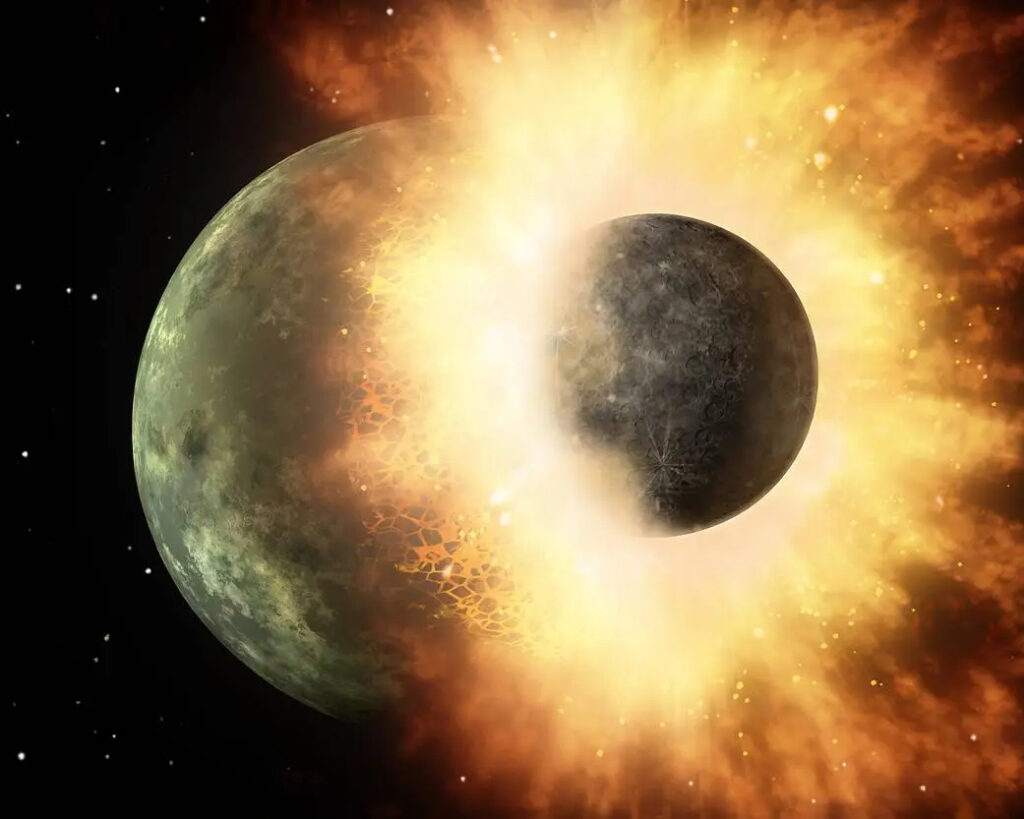How our Moon formed – the least implausible theory
It is a sobering thought that if it wasn’t for our Moon, Earth would be a very different place and we would certainly not be inhabiting it. The Moon acts to stabilise our tilt axis which has the effect of also stabilising our climate, over the timescales needed for life to evolve. No Moon, probably no evolution, no us! For our February meeting, FAS member David Lewis took up the challenge of summarising the various theories about how our Moon formed and explaining why the “Giant Impactor” theory, unlikely though it may seem, is now generally accepted.
Early theories about how the Moon formed – and why they can’t be true
The fission theory for the Moon’s formation was put forward by George Darwin in the late 19th century. He proposed that because of the spin of the Earth, a portion of it could become detached and flung off, being captured into orbit by the Earth’s gravitational field.
As it happens, the size of the Moon is about the same as the Pacific Ocean basin, making it a tempting source of the Moon’s material. Now, George had a good academic pedigree, being the son of Charles Darwin. However his theory has been discounted as the orbital speeds needed to cause this effect are too high. Even allowing for the tidal drag of the Moon, slowing our rotation over millions of years, it is estimated that we would still be having 8 hour days if this theory were true.
Perhaps a bit more plausible at first glance is the “Capture” theory. This suggests that the Moon just happened to be passing by and was drawn into a stable orbit by the Earth’s gravitational field. The problem here is the “just happened to be passing by” concept. The conditions for such an encounter to produce a stable orbit are very restrictive making the event very unlikely. We now know, thanks to the lunar-landing missions, that the composition of the Earth and Moon are similar which suggests they had a common origin. Bad news for the Capture theory.
A third theory was described as the “Co-accretion Condensation” model. Here it is assumed that the Moon and the Earth form at the same time by the collecting together of planetisimals. The problem here is why did we end up with two bodies when it seems more reasonable to predict that at an early stage one body might collect a bit more of the material, giving it more graviational attraction and hence go on to “win” the rest of the material?
The Giant Impactor theory
David presented the Giant Impactor theory as the least implausible theory. It is currently accepted as correct “because the others are wrong”. In this theory, a Mars-sized object is thought to have crashed into Earth. The resulting debris was flung out, coalescing into the Moon we have today.

However unlikely this scenario might seem, there is some compelling evidence to support it. One piece of evidence is that the N-S axis is tilted suggesting that there was an impact to displace it from its “upright” position. Also, the Apollo missions mentioned above showed that in some respects the composition of the Earth and Moon are very similar. For example, the ratio of oxygen isotopes is almost identical. (The Moon’s oxygen is in the form of oxides making up its rocky nature). You could say that this is evidence against the Giant Impactor theory – why would the impactor have the same composition as the Earth? The current explanation lies in the amount of debris mixing there must have been between the two objects.
There have been simulations of the effects of the collision using a technique called Smooth Particle Hydrodynamics in which the fate of the “particles” formed by the collision has been modelled. This is no easy computational task. Assuming the debris is in the form of 400km particles, the simulation has to keep track of 1.4 billion gravitational interactions. Using a more realistic particle size of 10km, there would be over a billion, billion, billion interactions and no computer yet developed could cope with that! Nothing has come out of those simulations to undermine the theory.
Problems remain(!) but for the time being, the Giant Impactor Theory survives as the least implausible theory available.
The most useful website I found which covers this topic in more scientific detail can be found by clicking here.
Talk given by FAS member David Lewis
Post written by Katherine Rusbridge
Jan 2019
